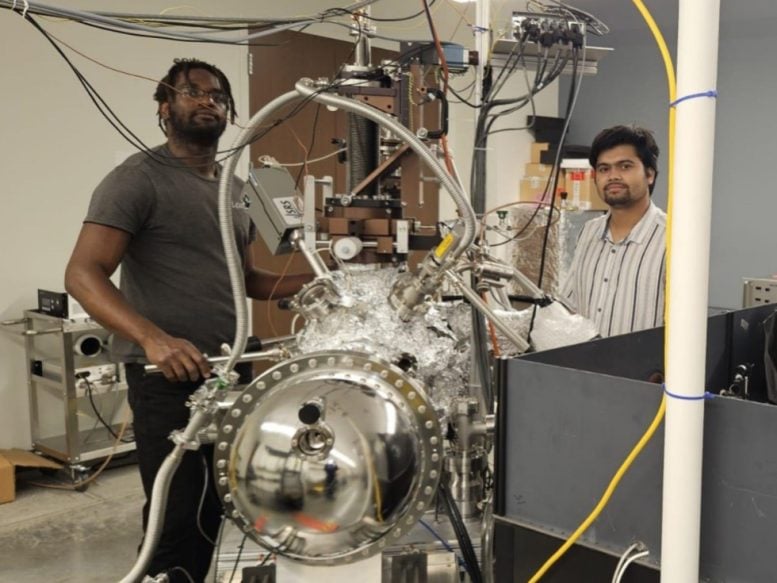
New research partially explains the exceptional performance of a new class of organic semiconductors called non-fullerene acceptors (NFAs).
Solar energy plays a vital role in the transition to a clean-energy future. Typically, silicon, a common semiconductor found in everyday electronics, is used to harvest solar energy. However, silicon solar panels come with limitations—they are costly and challenging to install on curved surfaces.
Researchers have developed alternative materials for solar-energy harvesting to solve such shortcomings. Among the most promising of these are called “organic” semiconductors, carbon-based semiconductors that are Earth-abundant, cheaper, and environmentally friendly.
“They can potentially lower the production cost for solar panels because these materials can be coated on arbitrary surfaces using solution-based methods – just like how we paint a wall,” said Wai-Lun Chan, associate professor of physics and astronomy at the University of Kansas. “These organic materials can be tuned to absorb light at selected wavelengths, which can be used to create transparent solar panels or panels with different colors. These characteristics make organic solar panels particularly suitable for use in next-generation green and sustainable buildings.”
While organic semiconductors already have been used in the display panel of consumer electronics such as cell phones, TVs, and virtual-reality headsets, they have not been widely used in commercial solar panels yet. One shortcoming of organic solar cells has been their low light-to-electric conversion efficiency, about 12% versus single crystalline silicon solar cells that perform at an efficiency of 25%.
According to Chan, electrons in organic semiconductors typically bind to their positive counterparts known as “holes.” In this way, light absorbed by organic semiconductors often produces electrically neutral quasiparticles known as “excitons.”
Breakthrough with Non-Fullerene Acceptors
But the recent development of a new class of organic semiconductors known as non-fullerene acceptors (NFAs) changed this paradigm. Organic solar cells made with NFAs can reach an efficiency closer to the 20% mark.
Despite their outstanding performance, it’s remained unclear to the scientific community why this new class of NFAs significantly outperforms other organic semiconductors.
In a breakthrough study appearing in Advanced Materials, Chan and his team, including graduate students Kushal Rijal (lead author), Neno Fuller and Fatimah Rudayni from the department of Physics and Astronomy, and in collaboration with Cindy Berrie, professor of chemistry at KU, have discovered a microscopic mechanism that solves in part the outstanding performance achieved by an NFA.

The key to this discovery was measurements taken by lead author Rijal using an experimental technique dubbed the “time-resolved two photon photoemission spectroscopy” or TR-TPPE. This method allowed the team to track the energy of excited electrons with a sub-picosecond time resolution (less than a trillionth of one second).
“In these measurements, Kushal [Rijal] observed that some of the optically excited electrons in the NFA can gain energy from the environment instead of losing energy to the environment,” said Chan. “This observation is counterintuitive because excited electrons typically lose their energy to the environment like a cup of hot coffee losing its heat to the surroundings.”
The team, whose work was supported by the Department of Energy’s Office of Basic Energy Sciences, believes this unusual process occurs on the microscopic scale thanks to the quantum behavior of electrons, which allows an excited electron to appear simultaneously on several molecules. This quantum weirdness pairs with the Second Law of Thermodynamics, which holds that every physical process will lead to an increase in the total entropy (often known as “disorder”) to produce the unusual energy gain process.
“In most cases, a hot object transfers heat to its cold surroundings because the heat transfer leads to an increase in the total entropy,” said Rijal. “But we found for organic molecules arranged in a specific nanoscale structure, the typical direction of the heat flow is reversed for the total entropy to increase. This reversed heat flow allows neutral excitons to gain heat from the environment and dissociates into a pair of positive and negative charges. These free charges can in turn produce electrical current.”
Implications for Future Energy Solutions
Based on their experimental findings, the team proposes that this entropy-driven charge separation mechanism allows organic solar cells made with NFAs to achieve a much better efficiency.
“Understanding the underlying charge separation mechanism will allow researchers to design new nanostructures to take advantage of entropy to direct heat, or energy, flow on the nanoscale,” Rijal said. “Despite entropy being a well-known concept in physics and chemistry, it’s rarely been actively utilized to improve the performance of energy conversion devices.”
Not only that: While the KU team believes the mechanism discovered in this work can be utilized to produce more efficient solar cells, they also think it can help researchers design more efficient photocatalysts for solar-fuel production, a photochemical process using sunlight to convert carbon dioxide into organic fuels.
Reference: “Endothermic Charge Separation Occurs Spontaneously in Non-Fullerene Acceptor/Polymer Bulk Heterojunction” by Kushal Rijal, Neno Fuller, Fatimah Rudayni, Nan Zhang, Xiaobing Zuo, Cindy L. Berrie, Hin-Lap Yip and Wai-Lun Chan, 19 May 2024, Advanced Materials.
DOI: 10.1002/adma.202400578